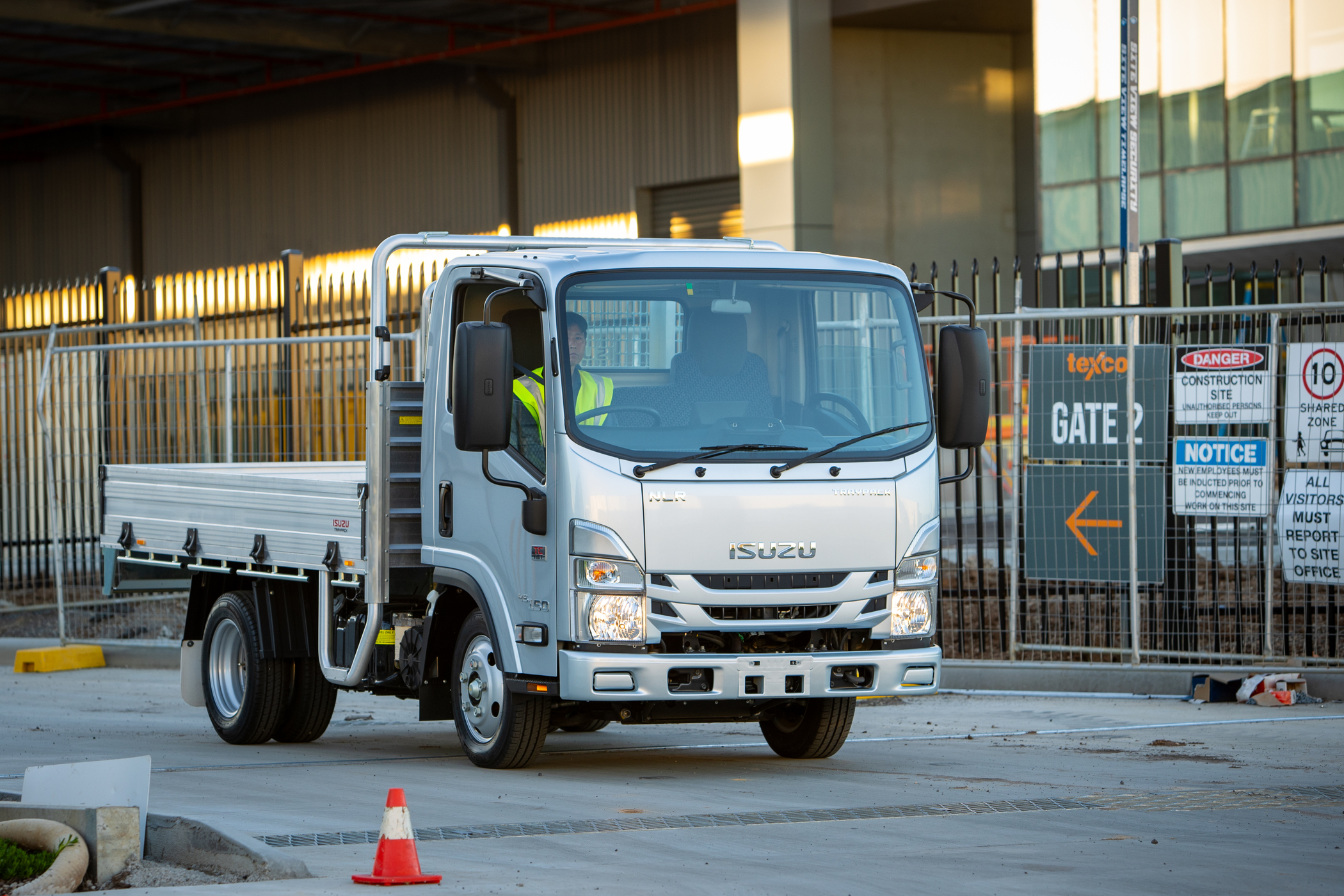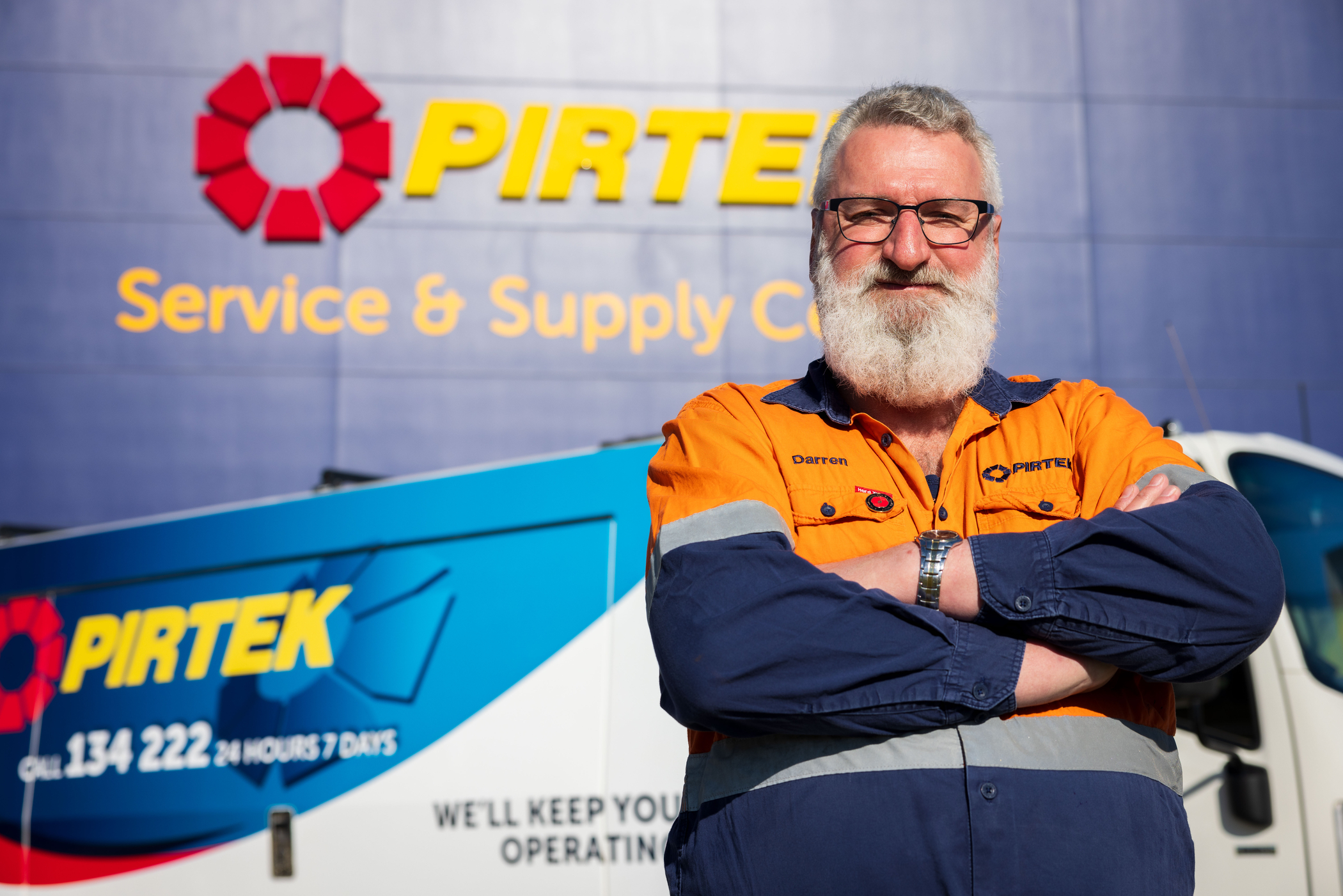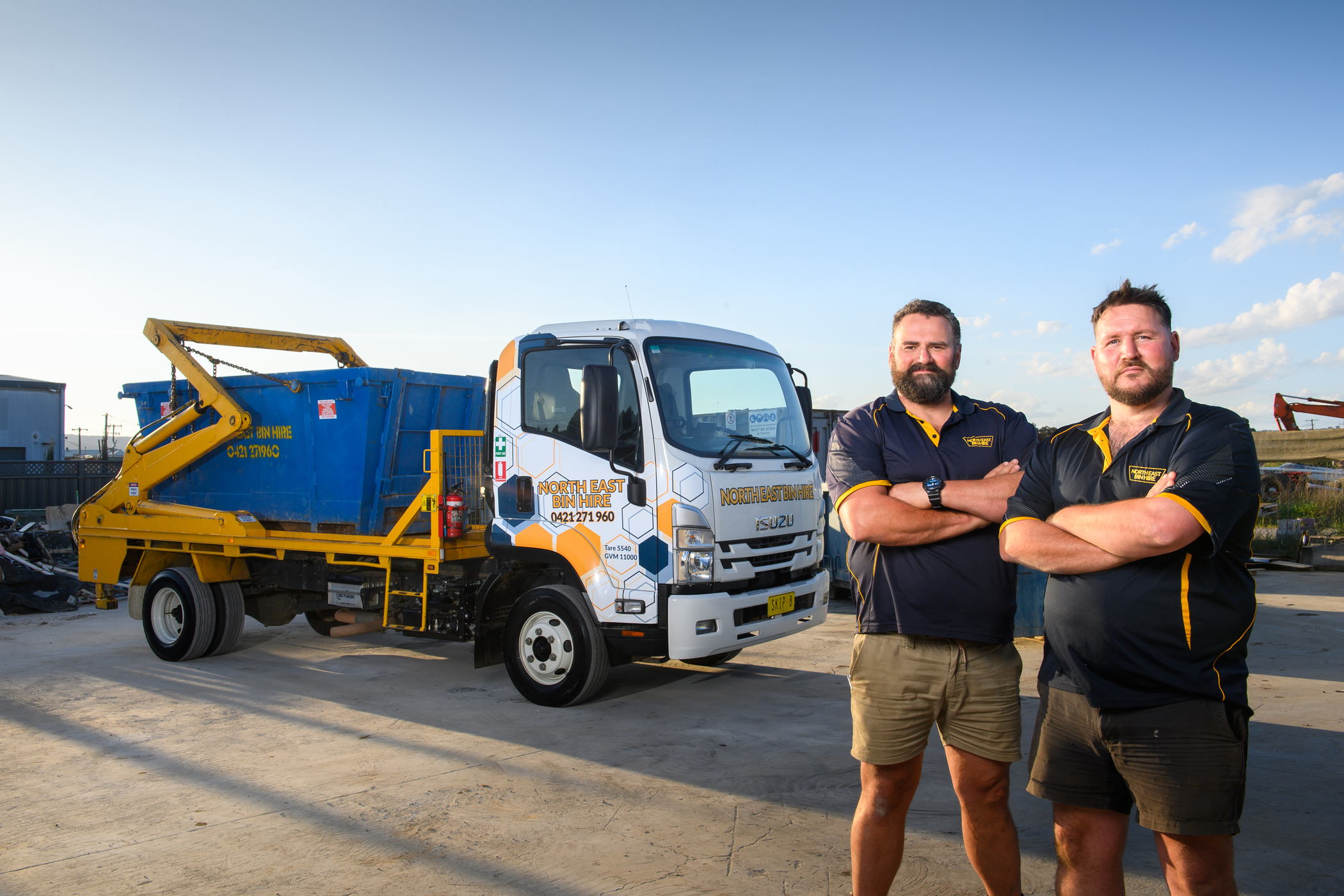Trucksales Blog – N Series Drive Day
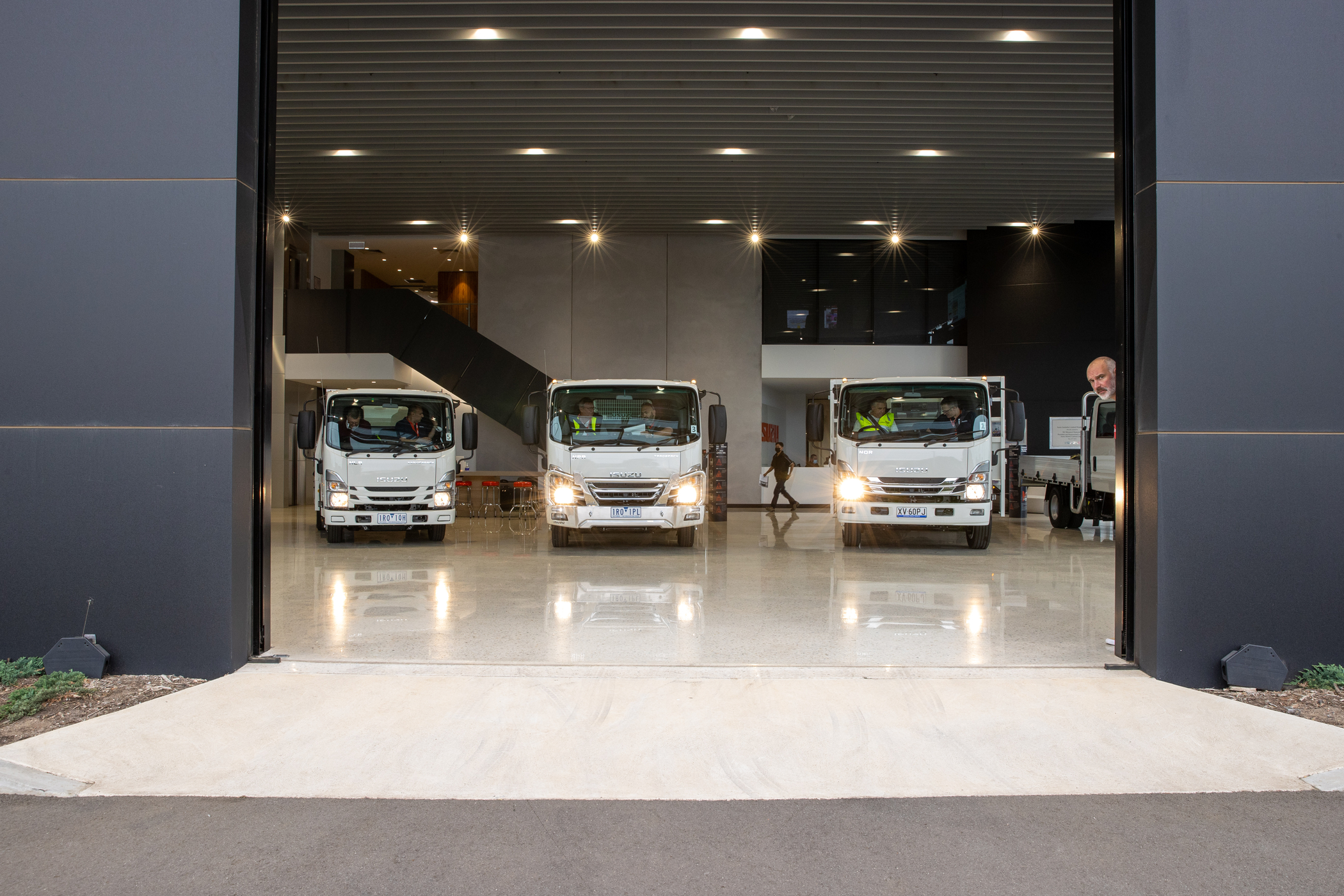
With restrictions easing and travel opening up, the Isuzu execs gathered members of the transport media for a proper drive day and briefing on the new N Series.
The updated N Series was officially launched in October last year and we’ve been fortunate enough to have driven a couple of examples since then, namely the 45-150 Traypack Crew and the 45-155 Tradepack.
However, for this drive, Isuzu had assembled a veritable smorgasbord of Ns; from the small but agile 45-155 Servicepack to an 87-190 Traypack LWB with an 8.7-tonne GVM and a tray that seemed to go on forever.
 Our drive kicked off at the National Headquarters of Isuzu Australia.
In between were collections of other N Series models from the Ready to Work range including the aforementioned 45-155 Tradepack and 45-150 Traypack dual cab, and a 75-190 NPR Freightpack.
For the uninitiated, the numbers in the Isuzu names reflect their GVM and their horsepower rating, so the 75-190 NPR has a GVM of 7.5 tonnes and 190hp.
Our drive kicked off at the National Headquarters of Isuzu Australia.
In between were collections of other N Series models from the Ready to Work range including the aforementioned 45-155 Tradepack and 45-150 Traypack dual cab, and a 75-190 NPR Freightpack.
For the uninitiated, the numbers in the Isuzu names reflect their GVM and their horsepower rating, so the 75-190 NPR has a GVM of 7.5 tonnes and 190hp.
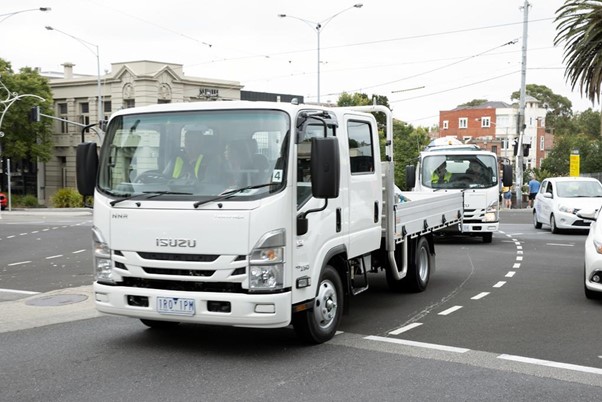 The drive program really showcased the N Series in its natural environment.
One of the big messages that Isuzu is trying to get across to tradies and the like, is that an N Series Ready to Work package is a far more versatile machine than an over-loaded ute. Isuzu has increased the towing capacity of the N Series with this update so that all new N Series trucks receive at least a 500kg increase in towing capacity — up to a 4500kg rating for models with 4HK1 engines (NPR, NQR and NPS models), and a 4000kg rating for all other models in the range.
And to that end, with the Tradepack for example, you get a 3500kg towbar as standard which is upgradeable to 4500kg as an option.
In a ute, as with all vehicles, the ball weight is taken as part of the GVM of the vehicle so that if you’re towing a heavy trailer you might have 350kg on the ball. Add in a couple of burley blokes up front, and that leaves precious little payload left for anything else.
The drive program really showcased the N Series in its natural environment.
One of the big messages that Isuzu is trying to get across to tradies and the like, is that an N Series Ready to Work package is a far more versatile machine than an over-loaded ute. Isuzu has increased the towing capacity of the N Series with this update so that all new N Series trucks receive at least a 500kg increase in towing capacity — up to a 4500kg rating for models with 4HK1 engines (NPR, NQR and NPS models), and a 4000kg rating for all other models in the range.
And to that end, with the Tradepack for example, you get a 3500kg towbar as standard which is upgradeable to 4500kg as an option.
In a ute, as with all vehicles, the ball weight is taken as part of the GVM of the vehicle so that if you’re towing a heavy trailer you might have 350kg on the ball. Add in a couple of burley blokes up front, and that leaves precious little payload left for anything else.
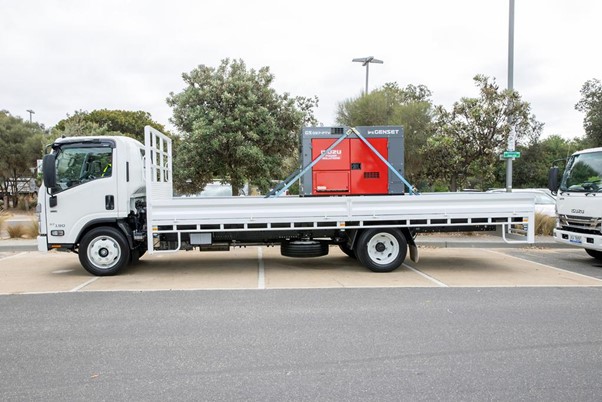 Even though the 87-190 Traypack was long, it was still quite manoeuvrable.
However, with a truck you can still carry a decent payload even if you’re towing a four-tonne trailer, and not be overloaded.
Even though the 87-190 Traypack was long, it was still quite manoeuvrable.
However, with a truck you can still carry a decent payload even if you’re towing a four-tonne trailer, and not be overloaded.
 The distance alert and the lane keeping warnings are adjustable to make them less sensitive.
The briefing of what’s in the ADAS package was pretty standard but what we didn’t know was that part of the system is customisable. Rather than turning off features like the lane departure warning, they can be customised to make them less intrusive. Using the toggle that pops out of the speedo (similar to that used to zero the trip meter) you can adjust the ‘width’ of the lane departure warning, making it less sensitive.
Similarly, you can adjust the distance warning so that it doesn’t beep as much when you’re closer to the vehicle in front. It’s better than turning the systems off completely and therefore ‘dumbing down’ your truck.
And there’s a bonus for the detractors of lane-departure warnings – it doesn’t come on until you’re doing over 60km/h, so it won’t bother you around town.
The distance alert and the lane keeping warnings are adjustable to make them less sensitive.
The briefing of what’s in the ADAS package was pretty standard but what we didn’t know was that part of the system is customisable. Rather than turning off features like the lane departure warning, they can be customised to make them less intrusive. Using the toggle that pops out of the speedo (similar to that used to zero the trip meter) you can adjust the ‘width’ of the lane departure warning, making it less sensitive.
Similarly, you can adjust the distance warning so that it doesn’t beep as much when you’re closer to the vehicle in front. It’s better than turning the systems off completely and therefore ‘dumbing down’ your truck.
And there’s a bonus for the detractors of lane-departure warnings – it doesn’t come on until you’re doing over 60km/h, so it won’t bother you around town.
 You can turn the systems off, but the default position is on, meaning you have to turn them off for every trip if that is your preference.
On our N Series tour, we also learnt a bit more about the ‘eyes’ of the new system, the Hitachi dual cameras.
According to Isuzu, this system has proven to be very accurate in object detection, as well as speed and depth perception (regardless of day or night operation).
Unlike other trucks in the market that offer a single camera attached to the windscreen (usually at the top) and a radar sensor mounted lower on the cabin face or bumper, Isuzu has mounted the dual-lens Hitachi camera inside the cabin in a central dashboard position that does not obstruct driver view and is not attached to the windscreen.
According to the manufacturer, this gives the camera a superior field of vision to detect lower-height objects while in motion (small children, for example), a critical advantage for those working in built-up areas.
You can turn the systems off, but the default position is on, meaning you have to turn them off for every trip if that is your preference.
On our N Series tour, we also learnt a bit more about the ‘eyes’ of the new system, the Hitachi dual cameras.
According to Isuzu, this system has proven to be very accurate in object detection, as well as speed and depth perception (regardless of day or night operation).
Unlike other trucks in the market that offer a single camera attached to the windscreen (usually at the top) and a radar sensor mounted lower on the cabin face or bumper, Isuzu has mounted the dual-lens Hitachi camera inside the cabin in a central dashboard position that does not obstruct driver view and is not attached to the windscreen.
According to the manufacturer, this gives the camera a superior field of vision to detect lower-height objects while in motion (small children, for example), a critical advantage for those working in built-up areas.
 Some of the assembled media and Isuzu staff at a driver swap in Melbourne.
Hence, the Isuzu engineers, including Mr Humphries, say that this system is more effective in urban areas.
Some of the assembled media and Isuzu staff at a driver swap in Melbourne.
Hence, the Isuzu engineers, including Mr Humphries, say that this system is more effective in urban areas.
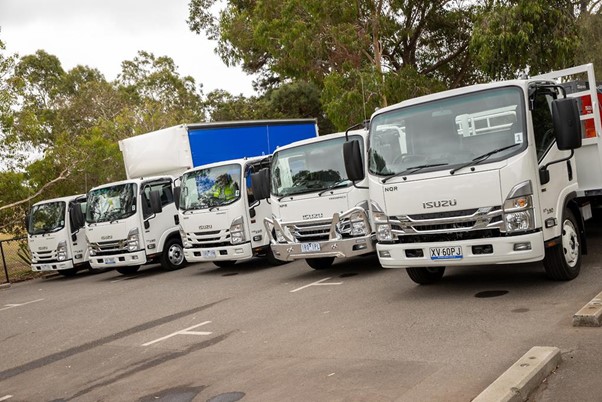 There are many iterations of the new Isuzu N Series.
He added that it represents good value for owners who are keen to reduce their downtime, boost productivity and maintain the resale value of the truck.
Having the servicing built into the price of the truck makes sense in that it is something that a business owner doesn’t have to worry about or allocate extra budget for down the track.
There are many iterations of the new Isuzu N Series.
He added that it represents good value for owners who are keen to reduce their downtime, boost productivity and maintain the resale value of the truck.
Having the servicing built into the price of the truck makes sense in that it is something that a business owner doesn’t have to worry about or allocate extra budget for down the track.
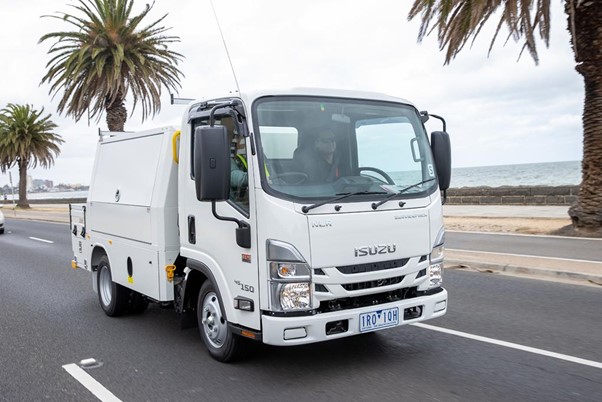 The NLR Servicepack proved a nimble handler in urban traffic.
Our test vehicles weren’t really carrying much of a load. A couple of them had Isuzu generators on them to settle them down a bit but the biggest of them was probably about 1500kg, so we really didn’t get to test the load-carrying ability of the vehicles. However, we have tested them loaded in the past and can attest to the fact that the N Series trucks are certainly fit for purpose, whatever that purpose may be.
Overall, we had a great day out in the Isuzu N Series driving around Melbourne. It certainly showed the truck in its preferred environment. It also showed us what the safety features are all about and how to set them and use them properly.
The new Isuzu N Series 4x2 cab-chassis range now comes with a six-year, 250,000km factory warranty, complemented by six years of 24-hour roadside assistance, which is the best in the business and should show potential owners the faith that Isuzu has in its products and their reliability.
Specifications:
Isuzu NPR 45-155 Tradepack
Engine: Isuzu 4HK1-TCN, four-cylinder, 16-valve SOHC
Displacement: 5.193 litres
Power: 155hp (114kW) at 2600rpm
Torque: 413Nm at 1600 to 2600rpm
Emission control: Cooled EGR with exhaust Diesel Oxidisation Catalyst (DOC), ADR 80/03 (Euro 5)
Transmission: Automated manual six-speed with auto and clutchless modes (six-speed manual available)
GVM: 4500kg (5500kg optional)
GCM: 9000kg (10,000kg optional)
Front axle: Reverse Elliot I-beam, 3100kg
Rear axle: Full-floating banjo, 6600kg
Diff ratio: 4.100:1
Brakes: Ventilated disc/drum with dual-circuit hydraulic control, vacuum assistance and EBD
Park brake: Transmission-mounted 190mm drum
Fuel tank: 100 litres
The NLR Servicepack proved a nimble handler in urban traffic.
Our test vehicles weren’t really carrying much of a load. A couple of them had Isuzu generators on them to settle them down a bit but the biggest of them was probably about 1500kg, so we really didn’t get to test the load-carrying ability of the vehicles. However, we have tested them loaded in the past and can attest to the fact that the N Series trucks are certainly fit for purpose, whatever that purpose may be.
Overall, we had a great day out in the Isuzu N Series driving around Melbourne. It certainly showed the truck in its preferred environment. It also showed us what the safety features are all about and how to set them and use them properly.
The new Isuzu N Series 4x2 cab-chassis range now comes with a six-year, 250,000km factory warranty, complemented by six years of 24-hour roadside assistance, which is the best in the business and should show potential owners the faith that Isuzu has in its products and their reliability.
Specifications:
Isuzu NPR 45-155 Tradepack
Engine: Isuzu 4HK1-TCN, four-cylinder, 16-valve SOHC
Displacement: 5.193 litres
Power: 155hp (114kW) at 2600rpm
Torque: 413Nm at 1600 to 2600rpm
Emission control: Cooled EGR with exhaust Diesel Oxidisation Catalyst (DOC), ADR 80/03 (Euro 5)
Transmission: Automated manual six-speed with auto and clutchless modes (six-speed manual available)
GVM: 4500kg (5500kg optional)
GCM: 9000kg (10,000kg optional)
Front axle: Reverse Elliot I-beam, 3100kg
Rear axle: Full-floating banjo, 6600kg
Diff ratio: 4.100:1
Brakes: Ventilated disc/drum with dual-circuit hydraulic control, vacuum assistance and EBD
Park brake: Transmission-mounted 190mm drum
Fuel tank: 100 litres

 Our drive kicked off at the National Headquarters of Isuzu Australia.
In between were collections of other N Series models from the Ready to Work range including the aforementioned 45-155 Tradepack and 45-150 Traypack dual cab, and a 75-190 NPR Freightpack.
For the uninitiated, the numbers in the Isuzu names reflect their GVM and their horsepower rating, so the 75-190 NPR has a GVM of 7.5 tonnes and 190hp.
Our drive kicked off at the National Headquarters of Isuzu Australia.
In between were collections of other N Series models from the Ready to Work range including the aforementioned 45-155 Tradepack and 45-150 Traypack dual cab, and a 75-190 NPR Freightpack.
For the uninitiated, the numbers in the Isuzu names reflect their GVM and their horsepower rating, so the 75-190 NPR has a GVM of 7.5 tonnes and 190hp.
Urban roaming
Our drive program was purposely designed to test out the trucks in their normal environment: city and urban driving. There’s no use running the N Series up and down the Hume, that’s not what they’re designed to do; although I dare say many could, and no doubt have, done some inter- and intrastate work. And indeed, some are used for recreational activities like towing caravans and being converted into motorhomes. But by and large, the N Series is designed as an urban workhorse and the Ready to Work range, and its success, is testament to that. The drive program really showcased the N Series in its natural environment.
One of the big messages that Isuzu is trying to get across to tradies and the like, is that an N Series Ready to Work package is a far more versatile machine than an over-loaded ute. Isuzu has increased the towing capacity of the N Series with this update so that all new N Series trucks receive at least a 500kg increase in towing capacity — up to a 4500kg rating for models with 4HK1 engines (NPR, NQR and NPS models), and a 4000kg rating for all other models in the range.
And to that end, with the Tradepack for example, you get a 3500kg towbar as standard which is upgradeable to 4500kg as an option.
In a ute, as with all vehicles, the ball weight is taken as part of the GVM of the vehicle so that if you’re towing a heavy trailer you might have 350kg on the ball. Add in a couple of burley blokes up front, and that leaves precious little payload left for anything else.
The drive program really showcased the N Series in its natural environment.
One of the big messages that Isuzu is trying to get across to tradies and the like, is that an N Series Ready to Work package is a far more versatile machine than an over-loaded ute. Isuzu has increased the towing capacity of the N Series with this update so that all new N Series trucks receive at least a 500kg increase in towing capacity — up to a 4500kg rating for models with 4HK1 engines (NPR, NQR and NPS models), and a 4000kg rating for all other models in the range.
And to that end, with the Tradepack for example, you get a 3500kg towbar as standard which is upgradeable to 4500kg as an option.
In a ute, as with all vehicles, the ball weight is taken as part of the GVM of the vehicle so that if you’re towing a heavy trailer you might have 350kg on the ball. Add in a couple of burley blokes up front, and that leaves precious little payload left for anything else.
 Even though the 87-190 Traypack was long, it was still quite manoeuvrable.
However, with a truck you can still carry a decent payload even if you’re towing a four-tonne trailer, and not be overloaded.
Even though the 87-190 Traypack was long, it was still quite manoeuvrable.
However, with a truck you can still carry a decent payload even if you’re towing a four-tonne trailer, and not be overloaded.
Safety tips
One of the great things about these drive days is that we as journos get exposure to the senior execs of the truck companies and they can give us a full rundown on the upgrades in the trucks – and this event was no exception. Before we left the massive building that is the headquarters of Isuzu Australia Limited (IAL), we were given a briefing of all the new safety features of the N Series by IAL’s Chief Engineer, Simon Humphries. Mr Humphries ran through all the standard features of the Advanced Driver Assistance System (ADAS). Isuzu’s ADAS features include advanced emergency braking (AEB) with forward collision warning (FCW), lane departure warning (LDW), traffic movement warning (TMW), distance warning system (DWS) and an auto lighting system (ALS). The distance alert and the lane keeping warnings are adjustable to make them less sensitive.
The briefing of what’s in the ADAS package was pretty standard but what we didn’t know was that part of the system is customisable. Rather than turning off features like the lane departure warning, they can be customised to make them less intrusive. Using the toggle that pops out of the speedo (similar to that used to zero the trip meter) you can adjust the ‘width’ of the lane departure warning, making it less sensitive.
Similarly, you can adjust the distance warning so that it doesn’t beep as much when you’re closer to the vehicle in front. It’s better than turning the systems off completely and therefore ‘dumbing down’ your truck.
And there’s a bonus for the detractors of lane-departure warnings – it doesn’t come on until you’re doing over 60km/h, so it won’t bother you around town.
The distance alert and the lane keeping warnings are adjustable to make them less sensitive.
The briefing of what’s in the ADAS package was pretty standard but what we didn’t know was that part of the system is customisable. Rather than turning off features like the lane departure warning, they can be customised to make them less intrusive. Using the toggle that pops out of the speedo (similar to that used to zero the trip meter) you can adjust the ‘width’ of the lane departure warning, making it less sensitive.
Similarly, you can adjust the distance warning so that it doesn’t beep as much when you’re closer to the vehicle in front. It’s better than turning the systems off completely and therefore ‘dumbing down’ your truck.
And there’s a bonus for the detractors of lane-departure warnings – it doesn’t come on until you’re doing over 60km/h, so it won’t bother you around town.
 You can turn the systems off, but the default position is on, meaning you have to turn them off for every trip if that is your preference.
On our N Series tour, we also learnt a bit more about the ‘eyes’ of the new system, the Hitachi dual cameras.
According to Isuzu, this system has proven to be very accurate in object detection, as well as speed and depth perception (regardless of day or night operation).
Unlike other trucks in the market that offer a single camera attached to the windscreen (usually at the top) and a radar sensor mounted lower on the cabin face or bumper, Isuzu has mounted the dual-lens Hitachi camera inside the cabin in a central dashboard position that does not obstruct driver view and is not attached to the windscreen.
According to the manufacturer, this gives the camera a superior field of vision to detect lower-height objects while in motion (small children, for example), a critical advantage for those working in built-up areas.
You can turn the systems off, but the default position is on, meaning you have to turn them off for every trip if that is your preference.
On our N Series tour, we also learnt a bit more about the ‘eyes’ of the new system, the Hitachi dual cameras.
According to Isuzu, this system has proven to be very accurate in object detection, as well as speed and depth perception (regardless of day or night operation).
Unlike other trucks in the market that offer a single camera attached to the windscreen (usually at the top) and a radar sensor mounted lower on the cabin face or bumper, Isuzu has mounted the dual-lens Hitachi camera inside the cabin in a central dashboard position that does not obstruct driver view and is not attached to the windscreen.
According to the manufacturer, this gives the camera a superior field of vision to detect lower-height objects while in motion (small children, for example), a critical advantage for those working in built-up areas.
 Some of the assembled media and Isuzu staff at a driver swap in Melbourne.
Hence, the Isuzu engineers, including Mr Humphries, say that this system is more effective in urban areas.
Some of the assembled media and Isuzu staff at a driver swap in Melbourne.
Hence, the Isuzu engineers, including Mr Humphries, say that this system is more effective in urban areas.
Chatting on the road
Our drive route took us in and around Melbourne from the Isuzu base in the trucking hub around Derrimut and Truganina, to the foreshore of Port Phillip at St Kilda and Elwood and then through Footscray to a lunch on the water at Williamstown, before heading back to Isuzu HQ. During the trip we shared rides with various Isuzu execs, including Brett Stewart, Isuzu's National Service Manager. Brett regaled me with all matters pertaining to service and aftersales support. Related reading: New Isuzu N Series is here Outdoor residential finds a ripper tipper Isuzu's 33rd year at the top Isuzu is a company that prides itself on aftersales support and Brett said one of the big parts of that support is service agreements where the servicing of the truck is built into the price. Called Isuzu Essentials, and released last March, the basic service agreement covers a new truck for three years or 60,000km, whichever comes first. “Our new Isuzu Essentials package is designed to take the stress out of scheduling and budgeting for those first three critical years of truck servicing,” Brett said. There are many iterations of the new Isuzu N Series.
He added that it represents good value for owners who are keen to reduce their downtime, boost productivity and maintain the resale value of the truck.
Having the servicing built into the price of the truck makes sense in that it is something that a business owner doesn’t have to worry about or allocate extra budget for down the track.
There are many iterations of the new Isuzu N Series.
He added that it represents good value for owners who are keen to reduce their downtime, boost productivity and maintain the resale value of the truck.
Having the servicing built into the price of the truck makes sense in that it is something that a business owner doesn’t have to worry about or allocate extra budget for down the track.
Increased comfort
With the update of the N Series, we were told that all new 4x2 N Series trucks will be fitted with suspension seats, which will be a bonus to buyers and provide an easier ride. One of our test vehicles didn’t have a suspension seat as it was a pre-production truck, but it didn’t really matter as the ride was fine by light-truck standards. Handling was good too, and manoeuvrability was excellent as we found out when we got lost and had to do a few snappy U-turns in the confines of suburban Elwood. The NLR Servicepack proved a nimble handler in urban traffic.
Our test vehicles weren’t really carrying much of a load. A couple of them had Isuzu generators on them to settle them down a bit but the biggest of them was probably about 1500kg, so we really didn’t get to test the load-carrying ability of the vehicles. However, we have tested them loaded in the past and can attest to the fact that the N Series trucks are certainly fit for purpose, whatever that purpose may be.
Overall, we had a great day out in the Isuzu N Series driving around Melbourne. It certainly showed the truck in its preferred environment. It also showed us what the safety features are all about and how to set them and use them properly.
The new Isuzu N Series 4x2 cab-chassis range now comes with a six-year, 250,000km factory warranty, complemented by six years of 24-hour roadside assistance, which is the best in the business and should show potential owners the faith that Isuzu has in its products and their reliability.
Specifications:
Isuzu NPR 45-155 Tradepack
Engine: Isuzu 4HK1-TCN, four-cylinder, 16-valve SOHC
Displacement: 5.193 litres
Power: 155hp (114kW) at 2600rpm
Torque: 413Nm at 1600 to 2600rpm
Emission control: Cooled EGR with exhaust Diesel Oxidisation Catalyst (DOC), ADR 80/03 (Euro 5)
Transmission: Automated manual six-speed with auto and clutchless modes (six-speed manual available)
GVM: 4500kg (5500kg optional)
GCM: 9000kg (10,000kg optional)
Front axle: Reverse Elliot I-beam, 3100kg
Rear axle: Full-floating banjo, 6600kg
Diff ratio: 4.100:1
Brakes: Ventilated disc/drum with dual-circuit hydraulic control, vacuum assistance and EBD
Park brake: Transmission-mounted 190mm drum
Fuel tank: 100 litres
The NLR Servicepack proved a nimble handler in urban traffic.
Our test vehicles weren’t really carrying much of a load. A couple of them had Isuzu generators on them to settle them down a bit but the biggest of them was probably about 1500kg, so we really didn’t get to test the load-carrying ability of the vehicles. However, we have tested them loaded in the past and can attest to the fact that the N Series trucks are certainly fit for purpose, whatever that purpose may be.
Overall, we had a great day out in the Isuzu N Series driving around Melbourne. It certainly showed the truck in its preferred environment. It also showed us what the safety features are all about and how to set them and use them properly.
The new Isuzu N Series 4x2 cab-chassis range now comes with a six-year, 250,000km factory warranty, complemented by six years of 24-hour roadside assistance, which is the best in the business and should show potential owners the faith that Isuzu has in its products and their reliability.
Specifications:
Isuzu NPR 45-155 Tradepack
Engine: Isuzu 4HK1-TCN, four-cylinder, 16-valve SOHC
Displacement: 5.193 litres
Power: 155hp (114kW) at 2600rpm
Torque: 413Nm at 1600 to 2600rpm
Emission control: Cooled EGR with exhaust Diesel Oxidisation Catalyst (DOC), ADR 80/03 (Euro 5)
Transmission: Automated manual six-speed with auto and clutchless modes (six-speed manual available)
GVM: 4500kg (5500kg optional)
GCM: 9000kg (10,000kg optional)
Front axle: Reverse Elliot I-beam, 3100kg
Rear axle: Full-floating banjo, 6600kg
Diff ratio: 4.100:1
Brakes: Ventilated disc/drum with dual-circuit hydraulic control, vacuum assistance and EBD
Park brake: Transmission-mounted 190mm drum
Fuel tank: 100 litres



Playtime’s over, get $3,500* to spend on extras.
If you’re ready to get serious about tackling bigger jobs, grab yourself an NLR 45-150 AMT SWB Traypack from the Ready-to-Work range for $62,990 drive away*. And to prove we aren’t playing, buy any NLR Traypack before June 30 and you’ll get $3,500* to spend on genuine accessories or an Essentials service agreement.
Learn more
